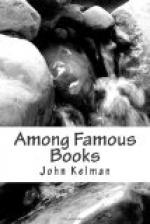The characteristics of his style were also those both of his thought and of his character. Dr. Gosse has summed up the reserve and shy reticence and the fastidious taste which always characterise his work, in saying that he was “one of the most exquisite, most self-respecting, the most individual prose writers of the age.” Even in the matter of style he consciously respected his own individuality, refusing to read either Stevenson or Kipling for fear that their masterful strength might lead him out of his path. Certainly his bitterest enemies could not accuse him of borrowing from either of them. Mr. Kipling is apt to sacrifice everything to force, while Pater is perhaps the gentlest writer of our time. In Stevenson there is a delicate and yet vigorous human passion, but also a sense of fitness, a consciousness of style that is all his own. He is preaching, and not swearing at you, as you often feel Mr. Kipling to be doing. To preach at one may be indeed to take a great liberty, but of course much will depend upon whether the preaching is good preaching. Be that as it may, Pater is distinctive, and borrows nothing from any writer whose influence can be traced in his work. He neither swears nor preaches, but weaves about his reader a subtle film of thought, through whose gossamer all things seem to suffer a curious change, and to become harmonious and suggestive, as dark and quiet-coloured things often are. The writer does not force himself upon his readers, nor tempt even the most susceptible to imitate him; rather he presupposes himself, and dominates without appearing. His reticence, to which we have already referred, is one of his most characteristic qualities. Dr. Gosse ascribes it to a somewhat low and sluggish vitality of physical spirits. For one in this condition “the first idea in the presence of anything too vivacious is to retreat, and the most obvious form of social retreat is what we call affectation.” That Pater’s style has impressed many readers as affected there can be no question, and it is as unquestionable that Dr. Gosse’s explanation is the true one.
His style has been much abused by critics who have found it easy to say smart things about such tempting peculiarities. We may admit at once that the writing is laboured and shows constant marks of the tool. The same criticism applies, for that matter, to much that Stevenson has written. But unless a man’s style is absolutely offensive, which Pater’s emphatically is not, it is a wise rule to accept it rather as a revelation of the man than as a chance for saying clever things. As one reads the work of some of our modern critics, one cannot but perceive and regret how much of pleasure and of profit their cleverness has cost them. Acknowledging his laboriousness and even his affectation, we still maintain that the style of Walter Pater is a very adequate expression of his mind. There is a calm suggestive atmosphere, a spirit half-childish and half-aged about




